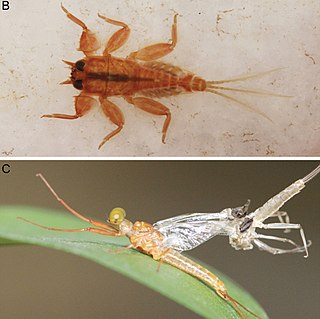
Baetis is a genus of mayflies of the family Baetidae, known as the blue-winged olive to anglers. There are at least 150 described species in Baetis. They are distributed worldwide, with the most variety in North America and northern Europe.

Rhithrogena is a genus of flatheaded mayflies in the family Heptageniidae. There are at least 150 described species in Rhithrogena.
Neoephemera is a genus of large squaregill mayflies in the family Neoephemeridae first described by McDunnough (1925). and containing approximately six described species in Neoephemera.

Prosopistomatidae is a family of mayflies. There is one extant genus, Prosopistoma, with several dozen species found across Afro-Eurasia and Oceania. They are noted for their unusual beetle-shaped larvae, which live beneath rocks and stones along the gravelly lower reaches of rivers. Their ecology is unclear, but they are probably carnivorous. They are closely related to Baetiscidae, with both families being placed in the Carapacea.
Ametropodidae is a family of mayflies in the order Ephemeroptera. There are at least three genera and three described species in Ametropodidae.
Potamanthus yunnanensis is a species of hacklegilled burrower mayfly in the family Potamanthidae.
Potamanthus formosus is a species of hacklegilled burrower mayfly in the family Potamanthidae.
Potamanthus idiocerus is a species of hacklegilled burrower mayfly in the family Potamanthidae.
Potamanthus huoshanensis is a species of hacklegilled burrower mayfly in the family Potamanthidae.
Potamanthus longitibius is a species of hacklegilled burrower mayfly in the family Potamanthidae.
Potamanthus macrophthalmus is a species of hacklegilled burrower mayfly in the family Potamanthidae.
Potamanthus nanchangi is a species of hacklegilled burrower mayfly in the family Potamanthidae.
Potamanthus sabahensis is a species of hacklegilled burrower mayfly in the family Potamanthidae.
Potamanthus sangangensis is a species of hacklegilled burrower mayfly in the family Potamanthidae.
Potamanthus subcostalis is a species of hacklegilled burrower mayfly in the family Potamanthidae.
Drunella spinifera is a species of spiny crawler mayfly in the family Ephemerellidae. It is found in southwestern and northern Canada and the western United States and Alaska.
Chane is a genus of small minnow mayflies in the family Baetidae. There is at least one described species in Chane, C. baure.
Gratia is a genus of small minnow mayflies in the family Baetidae. There are at least two described species in Gratia.
Siphloplecton is a genus of cleftfooted minnow mayflies in the family Metretopodidae. There are about 15 described species in Siphloplecton.

Vietnamellidae is a family of ephemerelloid mayflies. It contains a single extant genus, Vietnamella, with several species native to India, Southeast Asia, and China. A fossil genus Burmella is known from the Burmese amber of Myanmar, dating to the mid-Cretaceous around 100 million years ago.





